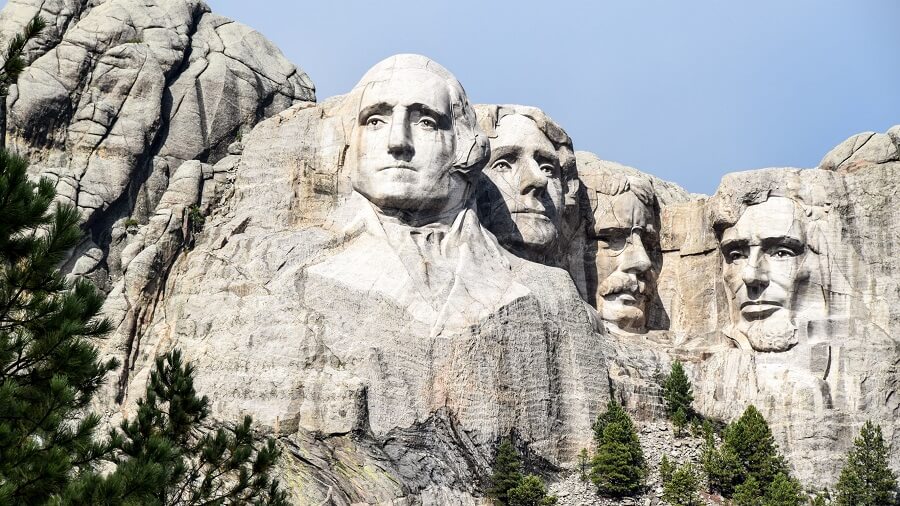by Tina Tackett
I have to admit that until a few years ago I was fairly unfamiliar with the “Mount Rushmore” game. This is the game where someone throws out a topic and the group is challenged with identifying which four people, foods, cocktails, sports, cars, movies, actresses, or any other category you can think of, deserve to be represented on that genre’s Mount Rushmore a la Washington, Jefferson, Lincoln, and Roosevelt. As I mentioned in my October blog, it’s a fun, fascinating, and insanely subjective game to play. But that’s what makes it so fun. I can tell you, at LOOMIS, we’ve had a blast debating our favorite challenger brands for these last two posts.
Last month, we looked at which challenger brands made the cut from 1950 to 2000. In this blog, we’re looking at the four underdog brands that have so distinguished themselves in the past 20 years, they deserve one of the four spots on our Challenger Brand Mount Rushmore since the turn of the century. It wasn’t easy, as this has already become the prime-time century for underdogs. But after much debate, we’ve narrowed it down to our favorite four.
The Challenger Brand Fab Four, 21st Century.
NETFLIX
If you work in any facet of advertising and marketing, you’ve most likely heard the cautionary tale about Netflix and the demise of Blockbuster. In the 80s and early 90s, Blockbuster Video stores were as ubiquitous as McDonalds. They were literally everywhere and dominated the video rental market in every hamlet, town, and city they were in. But in 1997, two software engineers named Reed Hastings and Marc Randolph envisioned an alternative to Blockbuster called Netflix where, for a monthly subscription, customers could get DVDs through the mail, that they could return any time they wanted, with no late fees. You watched when you could, mailed the DVD back in a Netflix-supplied sleeve, and waited for the next movie in your queue to arrive.
As technology and people’s digital capabilities caught up, Netflix took another step forward, shifting mainly to a streaming model. In 2000, Hastings approached Blockbuster about a merger for $50 million that would have put his team in charge of Blockbuster’s online rental program. Blockbuster declined. They reasoned there was no way the Netflix model could beat people’s love for picking up a movie at their Blockbuster down the street.
By 2004, Blockbuster’s market valuation reached $6 billion while Netflix was still climbing past $500 million. Five years later, Blockbuster had lost a third of its value while Netflix was about to crest $2 billion. A year later in 2010, Blockbuster declared bankruptcy. Call it poor management, hubris, or a lack of vision. I think it was all three.

Blockbuster could have been Netflix, even after Netflix was Netflix. But their unwillingness to embrace change and believe there could be something better killed them.
Fortune Favors the Brave.
As of this writing, Netflix has a market cap somewhere north of $286 billion. It offers customers access to more than 5,500 movies and TV shows for as little as $8.99 a month. It’s been ranked as the most valuable entertainment company in the world and, in just the past eight years, movies produced by Netflix have garnered 54 Academy Award nominations and eight wins. Netflix is the textbook challenger brand that took on the status quo and completely disrupted an entire category.
As of now, Netflix continues to rewrite the entertainment landscape and all because they were willing to go where the category leader wouldn’t. The question is, with all the new streaming platforms trying to steal their thunder, what will happen to Netflix now that they are the hunted and not the hunter?
RED BULL
In the crowded 90s-era soft drink category dominated by Coke and Pepsi, a tiny brand called Red Bull showed up in the U.S. with relentlessly aggressive grassroots focus on extreme sports and singlehandedly created the energy drink segment it would soon dominate. Red Bull flipped category convention on its head with a single oddly packaged, premium-priced, 8-ounce can of rocket fuel with the simple promise that it would “give you wings.” The claim that its ingredients actually fueled athletic performance was in doubt from the jump, but that was not the point at all.
Red Bull did something even more important for its carefully selected audience than give them a buzz. It embraced with unapologetic enthusiasm their belief that limits are for losers. When adrenaline junkies met Red Bull, they didn’t see a beverage company. They saw a kindred spirit. No start-up beverage company could afford to go toe-to-toe with the category killers through traditional advertising channels and Red Bull was no different. But it was a limitation they turned to their advantage.
For Challenger Brands, It’s Personal.
Red Bull had no choice but to make it personal, so they met their customers where they were, at local extreme sports events and competitions. They didn’t send in product reps wearing logoed shirts. They sent enthusiasts and greeted local fans with people who looked and behaved just like them. Red Bull got involved and organized events, handing out free samples of their product and offering modest sponsorship for the minor extreme sports celebrities who held sway. Their early hands-on efforts succeeded in something few brands try to do.

Remarkably, Red Bull soared by recognizing and then building the social context for the role the brand would assume.
Through intense engagement and aggressive support of extreme sport athletes and fans alike, Red Bull built its reputation as their champion. The company ushered in a new era of influencer marketing whose magic is its execution by peers, for peers. In doing so, the company built and fortified an unassailable brand advantage the cola giants never saw coming.
Since the turn of the century, by virtue of its strong brand congruence and the behavior it informs, Red Bull has become a trusted and influential extreme sports industry insider. It’s become a brand for the fans, catalyzing the community with extraordinary engagement and nourishing the very ecosystem that supports it. A quick review of redbull.com today reveals its enviable center pole role propping up the tent for extreme sports enthusiasts around the globe.
Deliver, Deliver, Deliver.
The key to Red Bull’s success has been its airtight alignment between what it promised customers and the way it behaved while delivering on that promise. Red Bull didn’t simply target its users. It assumed its place among them, selling more than 7.5 BILLION cans globally in 2020 alone. Red Bull now enjoys a lighthouse identity in a category it created as an underdog. That alone is enough to put it on our 21st Century Mount Rushmore for challenger brands.
AMAZON
As we sit here in November, 2021, Amazon accounts for 41 percent of all American online buying. To put that number in perspective, Wal-Mart is second with 6.6 percent. In 2020, Amazon’s revenue topped $386 billion which, thanks to COVID, was $100 billion more than the year before. Books, movies, clothes, groceries, toys… the numbers are so dominant, so mind-boggling, it’s almost impossible to think of Amazon as an underdog in anything. And yet, at the turn of the century, Amazon was a yet unrealized “what if” operating out of Jeff Bezos’s rented garage.
As the story goes, Bezos’s idea for Amazon came after he read a report about the future of the internet that projected a 2,300 percent increase in annual web commerce. Bezos wrote down 20 products that could be marketed online and then trimmed the list to the five he thought had the most potential. From CDs, videos, computer software, computer hardware, and books, he chose books because people around the world read, books are relatively cheap, and there are gazillions of titles already in print. In retrospect, Amazon seems inevitable. But that sells Bezos short. Amazon worked because of the mindset he brought to the vision.
The Real Reasons Amazon Became Amazon.
Amazon started as the quintessential challenger brand and from the jump Bezos brought the challenger mindset to his vision for the company. For challenger brands to compete, there are three states that distinguish them from the category leaders they are chasing.
First is State of Market. Challengers have to understand their position in the marketplace, or in the category where they are competing. In the case of Amazon, the marketplace was in its infancy and Bezos figured out how to prime demand and make the market work.

Just like when FedEx convinced the world packages had to get somewhere overnight, Bezos expanded our want for instant gratification and changed the way we bought everything.
Second is State of Mind. Challenger brands have to understand who they are. Challengers are either the best at delivering something important to a specific group of customers, or they are striving to be the best. While books per se may not have been Bezos’s passion, the process for delivering them on demand was. Bezos was smart enough, or brave enough, to acknowledge who he was, see where his company could play, and then create a need people didn’t even know they had.
Third is State of Readiness. It’s disingenuous to suggest anyone with an idea like Amazon could have been Amazon. Plenty of people had the same computer parts that Steve Jobs and Steve Wozniak had, but there’s only one Apple. State of Readiness speaks to how ready a company is to go to battle. Real challengers engender a willingness to embrace new ways of thinking and an organizational tolerance for calculated risk in service of transforming their big idea. Jeff Bezos did that as well as anyone in history. Amazon went from startup to one of the most dominant brands on the planet in 20 years. Without thinking like an underdog, that never would have happened.
APPLE
Wait a minute, wasn’t Apple on the first Challenger Brand Mount Rushmore for brands from 1950-2000? Indeed, it was. But if you know your Apple history, you know Apple is really a tale in two parts, each with a different incarnation of its visionary founder, Steve Jobs. For the vision it had in creating beautiful, customer-friendly personal computers and the marketing that went with them, Apple deserved a place among the best challenger brands of the 20th Century. But for everything the company has done after Steve Jobs came back, Apple is equally deserving to keep their spot for the century we’re in.
Is it me, or does it feel impossible that iPhones have only been around since 2007? Apple is no longer a computer company. It’s a technology company. In fact, Apple is the largest tech company in the world with 2020 sales just under $275 billion. MacBooks, iMacs, iPhones, iPads, Apple watches, Apple TV, the Apple+ content platform.

It’s no wonder that in January of this year, Apple became the world’s most valuable company. But what would you expect from a company with Apple’s kind of vision?
It’s All About The Challenger Brand Mindset.
Apple’s mindset has always been the magic in the company. Yes, it’s a tech company, but Apple’s really not about technology. It’s about what you can do with Apple technology and how it makes your life and the world around you better, smarter, more colorful, and more creative. You know Apple’s real secret? It extends the company’s underdog mindset to the millions who evangelize their products. Apple positions its customers as challengers. How will you change the world? What will you do to disrupt the status quo? How will you empower yourself to become the very best version of yourself you can be? However, you choose to do it, Apple will be there to help make it happen.
That’s why we love the underdogs. They make us believe that anything is possible. Challenger brands show us we can find a way where there is no way. Just look at the brands we’ve chosen for our 21st Century Challenger Brand Mount Rushmore. Netflix. Red Bull. Amazon. Apple. With vision, courage and good people, challenger brands can do anything.
The first step is believing you can.
TINA TACKETT is Executive Creative Director at LOOMIS, the country’s leading challenger brand advertising agency and a top Dallas advertising agency for digital, social, mobile and user experience. For more about challenger branding, advertising and marketing, leadership, culture and other inspirations that will drive your success, visit our blog BARK! The Voice of the Underdog and catch up on all of our posts.
For more about LOOMIS, or to discuss how we can help your company succeed, CLICK HERE
original content








